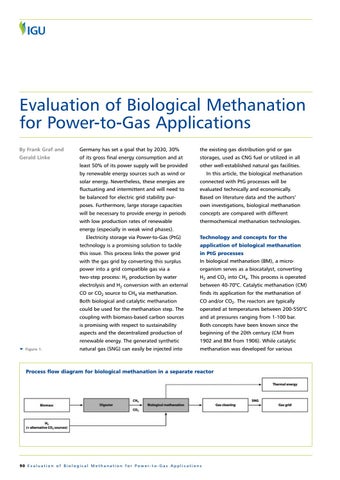Evaluation of Biological Methanation for Power-to-Gas Applications By Frank Graf and
Germany has set a goal that by 2030, 30%
the existing gas distribution grid or gas
Gerald Linke
of its gross final energy consumption and at
storages, used as CNG fuel or utilized in all
least 50% of its power supply will be provided
other well-established natural gas facilities.
by renewable energy sources such as wind or
In this article, the biological methanation
solar energy. Nevertheless, these energies are
connected with PtG processes will be
fluctuating and intermittent and will need to
evaluated technically and economically.
be balanced for electric grid stability pur
Based on literature data and the authors’
poses. Furthermore, large storage capacities
own investigations, biological methanation
will be necessary to provide energy in periods
concepts are compared with different
with low production rates of renewable
thermochemical methanation technologies.
energy (especially in weak wind phases). Electricity storage via Power-to-Gas (PtG)
x Figure 1.
Technology and concepts for the
technology is a promising solution to tackle
application of biological methanation
this issue. This process links the power grid
in PtG processes
with the gas grid by converting this surplus
In biological methanation (BM), a micro-
power into a grid compatible gas via a
organism serves as a biocatalyst, converting
two-step process: H2 production by water
H2 and CO2 into CH4. This process is operated
electrolysis and H2 conversion with an external
between 40-70°C. Catalytic methanation (CM)
CO or CO2 source to CH4 via methanation.
finds its application for the methanation of
Both biological and catalytic methanation
CO and/or CO2. The reactors are typically
could be used for the methanation step. The
operated at temperatures between 200-550°C
coupling with biomass-based carbon sources
and at pressures ranging from 1-100 bar.
is promising with respect to sustainability
Both concepts have been known since the
aspects and the decentralized production of
beginning of the 20th century (CM from
renewable energy. The generated synthetic
1902 and BM from 1906). While catalytic
natural gas (SNG) can easily be injected into
methanation was developed for various
Process flow diagram for biological methanation in a separate reactor
90 E v a l u a t i o n o f B i o l o g i c a l M e t h a n a t i o n f o r P o w e r - t o - G a s A p p l i c a t i o n s























